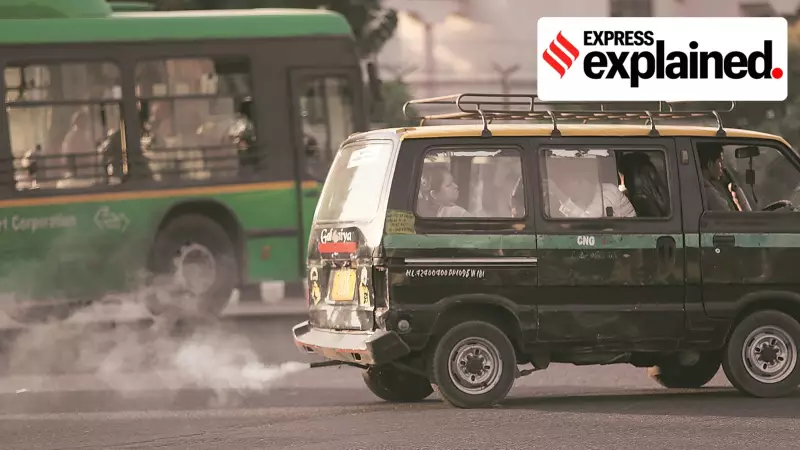
India's Auto Industry Divided Over Proposed Emission Norms
The Indian automotive sector finds itself sharply divided as the government proposes stricter fuel-efficiency regulations under the third phase of Corporate Average Fuel Efficiency (CAFE) rules. Scheduled to take effect from FY28, these new standards have triggered a fundamental debate about how small and large vehicles should be treated differently in the country's emissions reduction roadmap.
The Weight-Based Formula Controversy
At the heart of the dispute lies a weight-based formula that progressively tightens emission targets through FY32. The proposed framework uses the calculation: [0.002 x (W – 1170) + c], measured in petrol-equivalent litres per 100 km. Here W represents average fleet weight, 1,170kg serves as a fixed constant, and 'c' is a decreasing annual constant that makes regulations stricter over time.
The mathematical structure creates what many industry experts call an unequal burden on lighter vehicles. Analysis reveals that a small car weighing 740 kilograms would need to achieve 51 CO2 g/km by FY32, representing a 25% improvement from FY28 targets and a massive 48% enhancement from current CAFE 2 standards.
Meanwhile, a heavier SUV weighing 2,500 kg faces a much gentler improvement curve. Its FY32 target of 134.5 CO2 g/km represents only a 25% efficiency gain from current levels, despite being a significantly larger polluter in absolute terms.
Industry Leaders Take Opposing Positions
Market leader Maruti Suzuki, with its substantial portfolio of small cars including Alto, Wagon R and Celerio, has voiced strong concerns about the proposed framework. Chairman RC Bhargava argued that CAFE norms should primarily target larger vehicles for emissions reduction, not burden budget-friendly small cars that already operate on thin margins.
The company warns that pushing stringent targets onto entry-level vehicles risks making them unaffordable for first-time buyers, potentially accelerating the market's existing shift toward larger, more expensive vehicles.
In contrast, Tata Motors has expressed confidence in meeting the proposed standards. Shailesh Chandra, Managing Director and CEO of Tata Motors Passenger Vehicles, stated they have "absolutely no concerns in meeting CAFE norms." The company opposes defining small cars based on weight, arguing that such criteria could conflict with safety imperatives.
Global Comparisons and Local Realities
The Indian debate contrasts sharply with international practices. Several developed markets including the United States, China, South Korea and Japan provide relaxed emissions norms for smaller, lightweight vehicles. Even Europe, whose standards heavily influence India's Bharat Stage regulations, sets lower absolute CO₂ targets for bigger cars while offering more lenient targets for smaller models.
Industry executives warn that the proposed changes might encourage what they term "brick in the boot" strategies – manufacturers simply making bigger cars since targets for heavy vehicles remain comparatively relaxed. This could potentially price budget-conscious first-time buyers out of the market entirely.
The technological challenge also differs significantly between segments. Larger vehicles have greater scope for implementing emissions-reducing technologies like hybrid or full electric powertrains. Small cars, built to strict budget constraints, have limited room for such expensive upgrades without becoming unaffordable for their target audience.
Regulatory Adjustments and Industry Response
The proposed CAFE 3 norms do offer some concessions for certain small car categories. Vehicles with unladen mass up to 909 kg, engine capacity not exceeding 1,200 cc and length not exceeding 4,000 mm can claim an additional reduction of 3 g CO₂/km, capped at 9.0 g/km of CO₂ per reporting period.
However, the Society of Indian Automobile Manufacturers (SIAM) has informed the government that its members hold "mixed views" on this provision. Carmakers like Maruti and Renault want the reduction increased beyond 3 g CO₂/km, while others including Mahindra and Tata oppose any enhancement.
The new norms also propose transitioning from the current Modified Indian Driving Cycle (MIDC) to the Worldwide Harmonised Light Vehicles Test Procedure (WLTP), which the European Union adopted in 2018. This shift promises more accurate, real-world measurements, though Mahindra has requested the government to defer this migration.
As the debate continues, the auto industry awaits final regulations that will shape India's automotive landscape for years to come, balancing environmental goals with market realities and consumer affordability concerns.





